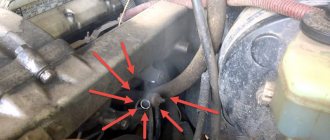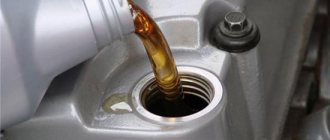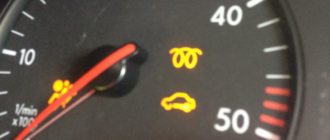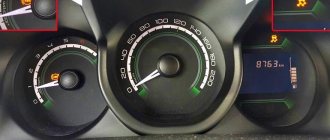Before answering the question: “Why is the engine breathing?”, it is necessary to understand what exactly is meant by this formulation. As a rule, this phrase characterizes the manifestation of excess gases in a power plant. Characteristic signs of this phenomenon can be considered smoke from the neck where oil is poured, leakage of working lubricant in various parts of the engine (breather, seals, etc.).
Oddly enough, if the engine starts to breathe, it’s too early to talk about any breakdown; you need to figure out what the reason is, since this phenomenon can manifest itself not only in units with high mileage, but also in completely new units, both gasoline and diesel
The breather is a special valve-type device designed to equalize the pressure inside the crankcase of the power plant with the ambient pressure. The process is quite simple: when pressure rises above atmospheric pressure, the valve opens and releases excess vapors to the outside, thereby ventilating the crankcase and removing gases.
Diesel engine breather - what does it mean?
To understand where the name came from, it’s worth understanding some of the principles of engine operation. During operation, excess pressure is created in the crankcase due to fuel combustion and high temperature. Over time, it can reach such levels that it begins to squeeze out lubricants wherever the seal is not very reliable.
To eliminate this problem, all engine manufacturers include a special ventilation valve called a breather in the design. It operates on a simple principle - when the pressure in the crankcase exceeds the set level, the unit is activated and releases it, leveling the indicators with atmospheric pressure. Due to this, the lubricant is not squeezed out, and the internal components are not subject to increased loads.
On a note!
The term “breathing” refers to engine oil leaks and other symptoms that occur when there is excess pressure inside the engine. Moreover, this definition applies to both diesel and gasoline cars.
How to diagnose
If the car continues to throw out engine oil through the breather valve, this behavior of the engine cannot be ignored. It is recommended to do diagnostics.
Potentially knowing why oil comes out through the breather and pollutes everything around it, one can draw certain conclusions regarding diagnostics.
To check and assess the condition, it is not necessary to disassemble the engine.
Sometimes it is enough to conduct a visual inspection and take a few measurements. It is important to consider that due to the design and technical features of a particular internal combustion engine, the procedure may have its own distinctive features.
Symptoms
To determine this malfunction, you do not need to be a professional mechanic, nor do you need special equipment. The first sign is oil leaks, which can form on the seals or in the area where the dipstick is located. There are many options for leaks, it all depends on the design features of the engine and the so-called “weak points”. But if oil appears where it was not there before, you need to deal with the problem.
The easiest way is to warm up the engine to operating temperature. You can simply stop after a trip and open the oil filler neck on the valve cover with the engine running. After this, you need to carefully observe it; if a bluish smoke is visible, then the problem has been confirmed and the internal combustion engine is indeed breathing.
Description of the design of the VAZ 2110 engine ventilation system
The breather with a fixed end of the pipe is located in the lower part of the cylinder block. The opposite end of the pipe connects to the oil separator located in the cylinder head cover. On the opposite side of the head, a special tube is connected to the fitting. This tube is connected to the air inlet pipe.
The operation of the system consists of the following stages:
- The passage of gases into the cavity of the head cover through the diesel breather.
- Separating the oil in the oil separator and supplying it to the valves.
- Mixing and supplying gases to the manifold through the air pipe.
The power unit of this car model is not equipped with a valve that regulates exhaust gas pressure.
In other cars, oil separators may be located in the area of the breather, behind which the pressure valve is located.
Why does a diesel engine bleed: reasons
There may be several options, but three reasons are the most common, so it is best to understand them. And if the search does not produce results, you can check additional nuances. The most common problems encountered are:
- The crankcase ventilation system is not functioning. The design is a breather with a valve, which, during normal operation, equalizes the indicators. But if the unit fails or becomes dirty, oil will be driven out due to excess pressure.
- Worn or stuck piston rings are a common cause that causes serious problems.
- Problems with cylinders and pistons. Also a significant problem that disrupts the normal operation of the engine and causes it to breathe.
Important!
You can carry out initial diagnostics yourself, but if complex problems have been identified, it is better to contact specialists.
Breather device
Typically, the internal structure of the breather is very simple. Let's look at it using the example of a breather for a gearbox/axle.
- External breather housing. It is made of metal, so it cannot be damaged while driving.
- Pressure spring. Thanks to it, the mechanism does not need an electrical/mechanical drive, everything is autonomous.
- Rubber gasket. It is this that ensures tightness when excess pressure is not released.
- Lock nut. The simplest method of fixation: although in other models there are a variety of options.
- The breather body itself. The through hole allows the unit to “breathe”, relieving excess pressure.
Although this breather is not used for engines, the principle is the same. An elementary module that you simply cannot do without.
Cylinder-piston group
Most often, this option is found on cars with high mileage, where wear on structural elements can be significant. During operation, various components are damaged. They can lose shape and change sizes, which leads to disruption of normal operation. It’s easy to check - you need to measure the compression readings in each cylinder. To do this, use a special device called a compression meter. It can be either mechanical or electronic, there is no fundamental difference.
The measurement process is simple and you can figure it out in a couple of minutes; there are many videos and instructions that describe each action in detail. Everything is quite simple - one person controls the indicators under the hood, and the second at this moment rotates the engine with the starter. It is imperative to take measurements in all cylinders, since it often happens that in three everything is fine, but in one the value does not correspond to the norm.
The generally accepted lower figure is 22 kg/cm2. But the optimal values may vary in different models; the easiest way is to study the operating instructions. If the number is about 30 or slightly higher, the condition of the cylinder-piston group is almost ideal and there is no point in worrying. But when one or more cylinders have values below the minimum, the problem may be one of the following:
- Damage to cartridges. Here you will have to do a major overhaul of the engine, grind and hone the liners, and also select repair rings. In addition, you have to do a number of additional works and replace all components that are worn out or damaged. In some cases, it is necessary to bore the engine and select pistons of larger diameter.
- Problems with pistons. During operation, they may become slightly deformed or damaged. Even a small piece that breaks off from the piston will cause serious problems that will lead to costly repairs. The elements may also burn out.
- Malfunctions can also be caused by other components - valves, bushings, seals, etc. It all depends on the situation and the cause can only be discovered by disassembling the motor. So there is not much difference in what exactly fails - the repair always looks about the same.
Important!
Individual engine models have their own characteristics and characteristic “sores”, so it is advisable to study the available information. For example, the D 245 tractor engine will be very different from the 1.9 TDI version from Volkswagen, both in design and layout. Therefore, it is worth understanding all the nuances.
: How effective is it?
Gazelle is an inexpensive piece of cardio equipment. You use your upper body and lower body muscles to push and pull the levels and move the pedals in circles.
The exercise machine is designed to build muscle tone and improve physical fitness. There are three models, each with slight differences.
You move the Gazelle by placing a foot on each leg plate and holding a handlebar in each hand. You then swing your legs back and forth in a gliding motion to glide. The faster you glide, the stronger your cardiovascular system is.
Because Gazelle machines have no impact, they are a great option for people with joint pain. Machines such as stairs or treadmills have more impact and can be hard on your joints.
Depending on the model, the glider can be configured for 6-10 different exercises, in addition to the basic one. These movements—such as wide glide, low glide, and high glide—target different muscles:
The handlebar or front bar position also creates variety in your workout. You can lean forward or backward to make your workout even harder.
So, although it is only one basic machine, a Gazelle user can change the configuration of the machine, change the position of their hands, or raise the heels of their feet to hit the body in a variety of ways in one workout.
You can only use your upper body by pressing down on the handlebars to move your legs. You can even glide without using your hands, which additionally works your back and core muscles.
The number of calories you burn on a Gazelle depends on many factors. Your weight, the intensity of your workout, and which Gazelle model you're using all come into play.
According to the manufacturer, a 150-pound person can expect to burn about 260 calories in a 30-minute workout on the Supreme Gazelle. That's about what you'd record in a decent clip on a bike, but less than what you'd record in the same amount of time.
Gazelle is available in three different models: Gazelle Edge, Gazelle Freestyle and Gazelle Supreme. All models fold for easy storage.
Gazelle Edge
The Edge is an introductory model, so it doesn't come with extras like a water bottle holder. It can be set to six core workouts and takes up slightly less space, making it a great option for apartments or other small living spaces.
Piston rings
Another detail that often causes diesel to breathe. The rings are designed to seal the gap between the pistons and cylinders; they are selected with a high degree of precision and provide them with good compression. But, if for some reason they do not perform their functions, exhaust gases penetrate into the crankcase. The problem is also detected when measuring compression and most often occurs for two reasons:
- Wear of elements, as a result of which they become thin and cannot properly seal the space. Sometimes the rings become so thin that they simply break, which can damage other components and complicate repairs.
- O-ring jamming occurs most often in cars that have been standing for a long time. That is, the elements stick to the pistons and do not seal the clearance, which is why the engine begins to breathe heavily. Also in this case, the engine malfunction lamp may come on periodically or constantly work.
In some cases, the oil can be squeezed out very strongly, it all depends on the extent of the problems with the rings and the amount of exhaust gases entering the crankcase. The main difficulty is that the cause is revealed only after removing the cylinder head.
Way to solve the problem
When starting to clean the breather, first of all we look for a device under the hood and remove the air filter from it. Before doing this, de-energize the car by disconnecting the negative terminal from the battery and turning off the ignition. There is an intake manifold under the filter - we will also dismantle it. After this, you can see the prompter itself - as a rule, its cover is secured with two bolts, which will have to be unscrewed. After removing the cover, the oil bumper will become visible - it is secured with a pin.
Read more: 220 Volts in Watts
It is necessary to unscrew the nut located on the stud, but there is no need to remove the stud itself, because it will be difficult to put it back without dismantling the pan. We make a cleaning rod out of wire, which we use to clean the tube. There is a brush on the breather cover to extinguish the flame - we clean that too.
All that remains is to check the device. We start the engine, remove the plug from the oil filler neck, and cover the neck itself with your palm. You can feel with your hand whether there is pressure. Then the assistant should press on the gas until the speed reaches 100-130 km/h and check the compression again by applying the palm of his hand. A little pressure should already be felt.
To avoid problems with the release of working fluid through the prompter, it is necessary to constantly monitor its level
It is also important to pay attention to checking the filter and gearbox
Owners of old domestic cars, after several years of ownership, can easily write a directory of “diseases” of a particular car model. One of these “sores” is an engine malfunction in which engine oil is squeezed out through the breather. This phenomenon is most often simply called by people: “oil is driven through the breather” or “oil is thrown out through the breather.”
The problem is quite unpleasant and is accompanied by a large number of engine-related problems. It is this problem, as you probably already guessed, that we will talk about in this article. You will learn why oil comes out of the breather and how to solve this problem. Go.
As a rule, the problem occurs with the onset of cold weather, the breather freezes and the oil is squeezed out. This manifests itself in the form of oil drips that are visible from the outside of the engine. Failure to respond to this phenomenon in a timely manner can lead to serious engine damage.
Crankcase ventilation
First you need to understand the design of the breather. Everything is quite simple - a hose or metal tube connects the crankcase and the upper part of the engine, creating a system for compensating pressure and reducing it, if necessary. The system also usually includes an oil separator, which prevents lubricant from escaping and returns it back to the engine.
Gas ventilation is usually designed so that air from the crankcase is supplied to the intake tract and used for operation. The design includes a crankcase ventilation valve (CVGV), which, when the pressure is exceeded, opens the membrane and releases the excess, thereby ensuring normal operation. If for some reason the valve is stuck in the open position, then air will be supplied to the intake, creating a vacuum in the engine, which has a bad effect on its operation and increases diesel fuel consumption.
If the valve fails in the closed position, excessive pressure will be created inside the crankcase and the oil will begin to be squeezed out through the seals, dipstick, etc. Also, large quantities of lubricant can enter the cylinders, which is also undesirable. In this case, oil consumption increases and blue smoke often appears.
Important!
The reason may also be clogging of pipes or other elements of the system; here it is important to check all components to eliminate the problem.
to “Smoke coming from the exhaust pipe - gray, blue, white, black smoke from the exhaust pipe”
A very useful article, definitely bookmark it, you should especially pay attention to the exhaust when you buy a car. If there is smoke, then avoid this vehicle.
It is difficult to determine the condition of the engine by the color of the smoke. My friend Moskvich has walked more than 100 thousand. Frankly, it is still unknown how it smokes. In the morning, cold engine - steam visible to the naked eye, closed the garage and drove off. I never warm up the engine. The rings are untouched and does not take oil. But we do chemicals regularly. We tried any serious additives. Determining seriousness by intuition. The fuel consumption of the new car remains the same. As for mechanical instruments, I use IKS to adjust the carburetor.
All visual diagnostics of the car’s condition based on the color of the smoke from the exhaust pipe are perfectly described. It may not be a 100% hit, but still the hint of a “diagnosis” is real. And by taking advantage of this, you can prevent the “disease” by carrying out a preventive check and the necessary adjustments.
Steam from the exhaust pipe should not always be ignored; if in cold weather it can somehow be explained, then when it is warm and such steam appears, then this indicates coolant leaks to the cylinders, and, therefore, it will be necessary to check the piston cuffs and rings, which are not maintain the tightness of the block. And also the formation of black smoke may not indicate any serious malfunctions, but only bad fuel, this is especially often noticeable in diesel cars.
In addition, you need to know that domestic cars “eat oil,” i.e. it simply gets into the fuel system and this is considered the norm, but on modern foreign cars this is not the case, the amount of oil you fill will be the same in a year. Therefore, the presence of oil in the engine and, accordingly, bluish-white smoke coming from the pipe, for domestic cars does not indicate a malfunction. I'm not even talking about the color of the smoke when you pour break-in oil into the car, which can be such a burnt color that I think even a showroom car will have a special smoke with it.
no, it’s not true, my VAZ 2103 hasn’t used a drop of oil in half a year
Alexey, I don’t believe that the VAZ troika can avoid eating butter. In order to reduce oil consumption, you need to at least overhaul the engine, change all the rings, pistons, cylinder block gaskets, and then I don’t think it will be possible to completely eliminate its consumption. And to measure the amount of oil at its minimum consumption, you can only completely drain the old one from the system, wash it and only then fill in new one, and after half a year, as you say, drain the oil again and see its quantity, but just know that it’s still in some part of it will remain in the system, so the statement that supposedly “not a drop of oil has been lost in half a year” is not true, or do you have some kind of ultra-precise measurement method. How did you measure? You certainly can’t tell by looking at the oil dipstick if it has decreased by 50 grams. Perhaps you simply did not correctly calculate the amount when you filled in new oil, did not take into account that there was also a certain amount of old oil left in the system, and you ended up with zero consumption.
The article warns and gives basic concepts on how to identify a malfunction. But judging by the reviews, everyone is super specialist, and VAZ can’t help but “eat” oil, and a foreign car is the limit of perfection - read the instructions for your foreign cars and the theory of internal combustion engines, after which you will stop being clever and writing nonsense. Thanks to all.
The information is useful but not fully described. There is such a thing as a car does not smoke, but sometimes it smokes with a bluish tint. The culprit in such a situation is worn out valve seals. This happens when the car brakes with the engine, at this time ignition does not occur, the oil collects in the cylinders and, if necessary, the driver presses the gas pedal, there is a short-term combustion of oil and fuel and we see a cloud of blue smoke released, then it all disappears and the car works normally. mode. or smoke may appear from excess pressure in the engine, which the dead valve seals are not able to cope with, this happens most often on long climbs.
The article is informative and useful. I can tell you how to get rid of the white cloud of smoke that appears due to water in the muffler. Everything can be done in a garage within ten minutes.
You will need: 1. Drill 2. Drill with a diameter of 3mm.
You need to visually mark the lowest point of your muffler and drill a hole there. All the moisture that previously collected in the muffler and created a large white cloud of smoke will flow out through this hole. Thanks to this hole, you will not only get rid of smoke, but also double the life of the muffler. The inside of the muffler will be constantly dry - therefore, corrosion will not develop.
By the way, the domestic auto industry used to make these technological holes in production. Then they stopped and started making good money selling new mufflers. I have been driving every day for six years on one muffler with a hole. A muffler without a hole lasted me a maximum of two years. And lastly, the hole does not affect the exhaust sound in any way.
I’ll give you some advice right away regarding the smoke from the exhaust pipe. The main thing to remember is that if you notice that thick black smoke is coming out of the exhaust pipe, then you shouldn’t panic right away! The reason may lie in the fuel itself, as correctly noted in the material above. Just let the car drive with this fuel. This is how you need to behave calmly, provided, of course, that you don’t notice any other faults with the car :-). And now, if after you refuel for the second time from another gas station, thick black smoke comes out again, then contact a car service center. There is no need to try to dig into this problem yourself, spend more effort and time, my advice to you. By the way, this has already happened to me twice this year. I fill up at one of the roadside gas stations of an unknown company and sometimes such a problem with smoke begins!
Valve check
Not everyone knows how to distinguish a burnt valve from stuck rings. Actually, it's all quite simple. To check, unscrew the spark plug from the suspect (low compression) cylinder. And check it out:
- If the rings are stuck or the piston is damaged, the spark plug will be thickly coated with oil. After all, the lubricant easily penetrates the cylinder;
- If the valve is burnt out, the spark plug will be in good condition, with virtually no changes.
This is how you can clarify the cause of oil leakage without disassembling the engine. This method gives a high level of accuracy.
Related articles:
- “Symptoms and signs of a burnt valve”;
- “What to do if rings are stuck in the engine.”
Conclusion
. As a rule, problems with oil release through the breather do not begin immediately. Gradually this problem begins to grow. As a result, the engine can throw out up to a liter of lubricant in a short period of time. That’s when drivers wonder why it drives and squeezes oil out of the breather. This really scares people, and the problem is aggravated by the lack of experienced diagnosticians in the services. Often, after “diagnosis”, car enthusiasts overhaul the power unit, although it was enough to reduce the lubricant level or clean the breather.











